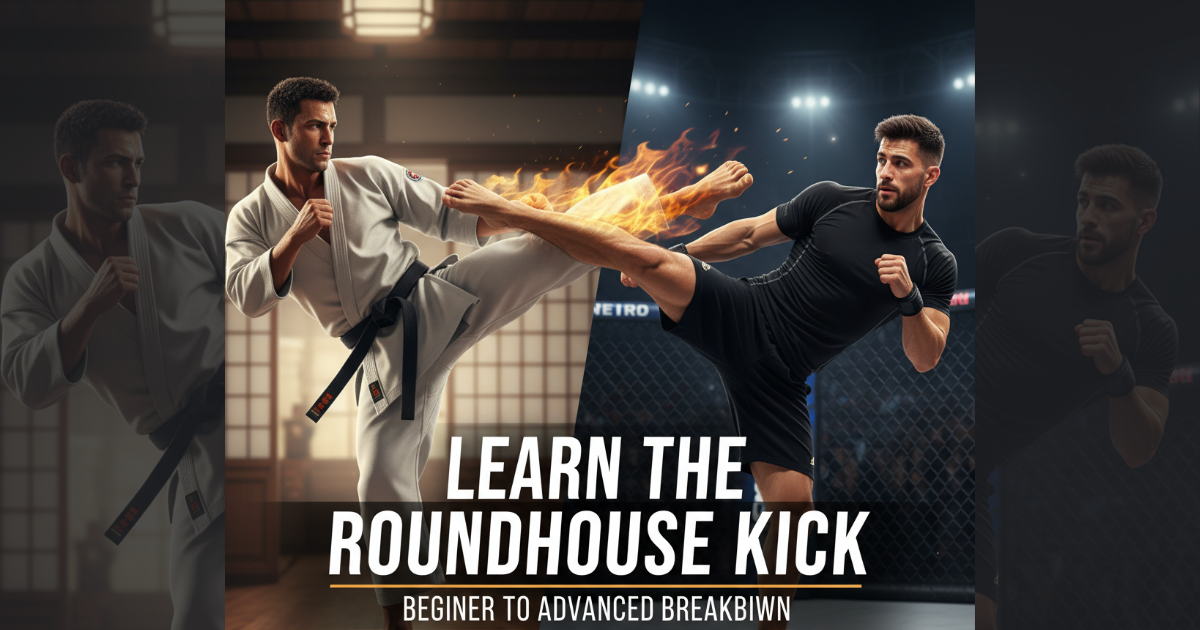SEO Title: Learn the Roundhouse Kick: 10-Step Powerful Breakdown for Beginners to Advanced Fighters
Meta Description: Learn the Roundhouse Kick step-by-step with this complete beginner-to-advanced breakdown. Master technique, power, balance, and speed safely and effectively.
Introduction to the Roundhouse Kick
Few techniques in martial arts are as iconic, versatile, and powerful as the Roundhouse Kick. Known for its speed, impact, and adaptability, this move appears in styles like Taekwondo, Muay Thai, Karate, and Kickboxing. Whether you’re a beginner stepping onto the mat for the first time or an advanced fighter refining your form, understanding the mechanics and purpose behind this kick is crucial.
The roundhouse kick teaches not just how to strike, but how to move with precision, timing, and control. It builds strength, coordination, and agility — all while sharpening your combat awareness.
What Is a Roundhouse Kick?
A roundhouse kick (also known as “mawashi geri” in Japanese or “te tat trong” in Thai) is a striking technique where the fighter lifts the leg, pivots on the supporting foot, and swings the kicking leg in a circular motion to hit the target — typically the opponent’s thigh, ribs, or head.
It’s a combination of speed, flexibility, and torque. The beauty of the roundhouse lies in its simplicity — yet, when executed properly, it becomes one of the most devastating and efficient strikes in combat sports.
The Importance of Mastering the Roundhouse Kick
Why focus so much on one kick? Because the roundhouse teaches you foundational skills essential for all martial arts:
- Balance – every strike requires equilibrium.
- Timing – knowing when to strike is key.
- Power generation – rotating through the hips and core.
- Adaptability – it can be thrown at various angles and heights.
Learning the roundhouse kick helps you develop discipline, rhythm, and control — traits that carry over into all aspects of martial training and fitness.
Understanding the Mechanics of the Kick
To master the kick, you must first understand how your body works during execution. The roundhouse kick involves a full-body motion, driven primarily by:
- Pivoting the support foot to align your hips.
- Rotating through the core to generate torque.
- Snapping or swinging the leg for impact.
- Retracting quickly to maintain balance.
The Role of the Hips and Core
Your hips are the engine of the roundhouse kick. Without proper hip rotation, your kick will lack both power and reach. Engaging your core stabilizes the movement and helps direct the energy from your legs into the strike.
Balance and Posture in Execution
A stable stance allows you to deliver maximum impact without losing your footing. Keep your guard up, spine straight, and head aligned with your target — this ensures both power and defense remain intact.
Step-by-Step: Beginner’s Guide to the Roundhouse Kick
Learning to perform the roundhouse kick involves mastering each stage deliberately:
Step 1 – Stance and Guard Position
Start with your feet shoulder-width apart, one foot slightly forward. Maintain a guard position to protect your face and ribs.
Step 2 – Pivot and Lift the Knee
Rotate on the ball of your supporting foot while lifting your kicking knee toward the target. Your hips should start turning sideways.
Step 3 – Extend the Kick and Snap Back
Extend your leg quickly, striking with the instep or shin depending on your style. Immediately retract the leg after impact.
Step 4 – Return to Fighting Position
Always return to your stance swiftly. A delayed recovery leaves you open to counterattacks.
Common Mistakes Beginners Make
Even seasoned athletes can fall into bad habits. Here are the top pitfalls to avoid:
- Not pivoting enough – reduces reach and power.
- Dropping the guard – exposes your upper body.
- Overcommitting – can cause loss of balance or injury.
- Neglecting flexibility – limits your kick height and fluidity.
Training Drills to Improve Your Roundhouse Kick
To perfect your roundhouse kick, you need to train both technique and muscle memory. Consistency builds power, speed, and precision — the three pillars of an effective martial artist.
Shadow Kicking and Heavy Bag Practice
Start with shadow kicks — performing the motion slowly without resistance. This helps you visualize your technique and refine your movement.
Then, move to heavy bag training:
- Low kicks for leg conditioning.
- Mid-level kicks for accuracy.
- High kicks for flexibility and control.
Heavy bag work develops timing, distance awareness, and impact control. Always focus on proper form before increasing power.
Partner Drills and Controlled Sparring
A training partner helps you learn timing and distance in real scenarios. Practice:
- Light roundhouse kicks against a partner’s pad.
- Controlled sparring to apply the kick dynamically.
This builds confidence in using the roundhouse kick in live combat or competitive settings.
Advanced Techniques and Variations
Once the basics are solid, progress to advanced variations. These techniques demand agility, precision, and control — so ensure you’ve built a strong foundation first.
Jumping Roundhouse Kick
This explosive variation adds vertical momentum to increase power and surprise your opponent.
Tip: Time your jump as your knee rises, then extend the leg mid-air for impact.
Spinning Roundhouse Kick
A dynamic and powerful move combining a spin and kick.
Execution: Rotate your body 360°, spotting your target over your shoulder before extending the leg.
This kick relies heavily on timing and core stability.
Double and Triple Roundhouse Kicks
These combinations involve throwing consecutive roundhouse kicks at different heights — for example, one to the leg, one to the body, and one to the head.
They improve endurance and train your body to transition smoothly between targets.
Conditioning and Flexibility Training
The best roundhouse kickers understand that flexibility and strength go hand in hand. Your muscles need to be both elastic and explosive.
Dynamic Stretching for Flexibility
Before every session, perform dynamic stretches:
- Leg swings (front-to-back and side-to-side)
- Hip circles
- Lunges with rotation
These movements warm up your joints and increase range of motion.
Core and Leg Strength Exercises
For power, focus on compound exercises such as:
- Squats and lunges for leg drive.
- Planks and Russian twists for core stability.
- Kettlebell swings to train explosive hip rotation.
These exercises help transfer energy efficiently from the ground up, resulting in faster, more powerful kicks.
Safety Tips and Injury Prevention
As you advance, the risk of overuse injuries grows. Follow these safety practices to protect yourself during training.
Warm-Up and Cool-Down Essentials
Never skip your warm-up — it primes your muscles and joints.
- Spend at least 10 minutes warming up.
- Include dynamic stretches before and static stretches after training.
- Use ice or compression if you feel soreness post-training.
Listening to Your Body
If you experience persistent pain or fatigue, take a rest day. Training through pain leads to injury and long-term setbacks.
Hydrate, stretch, and maintain proper nutrition — your recovery is just as vital as your practice.
FAQs About Learning the Roundhouse Kick
1. How long does it take to learn the roundhouse kick?
With consistent practice (2–3 times a week), most beginners can perform a proper roundhouse kick within 4–6 weeks. Mastery, however, may take months of refinement and conditioning.
2. Should I hit with my foot or shin?
It depends on the martial art. Taekwondo practitioners usually strike with the instep, while Muay Thai fighters prefer the shin for durability and power.
3. Do I need to be flexible to learn the roundhouse kick?
Not initially — flexibility develops naturally with training. However, adding stretching routines to your practice accelerates progress and prevents injuries.
4. Can I train the roundhouse kick at home?
Yes! You can practice shadow kicks, balance drills, and light bag work at home. Always ensure you have enough space and use proper footwear or mats for safety.
5. How can I increase the power of my roundhouse kick?
Focus on hip rotation, core engagement, and pivoting on your supporting foot. Power comes from coordination, not just muscle strength.
6. What’s the best way to practice control and accuracy?
Use a focus mitt or target pad at specific heights. Aim for consistent impact zones without overextending. Controlled repetitions improve precision and timing.
Conclusion: Mastering the Roundhouse Kick Through Consistency
Learning the roundhouse kick isn’t about raw strength — it’s about discipline, timing, and consistency. From your first slow shadow kick to a lightning-fast spinning roundhouse, every repetition builds mastery.
By combining proper mechanics, conditioning, and focus, you’ll transform this classic martial arts technique into a reliable and powerful tool — both in training and real-world application.
So tie your belt, hit the mat, and commit to practice. Your roundhouse kick will evolve with every session, proving that mastery is built one strike at a time.

